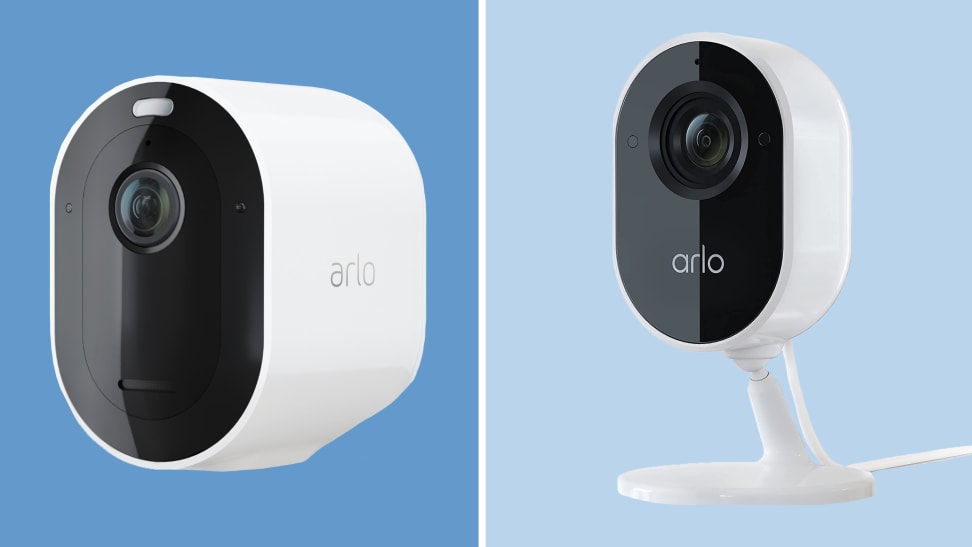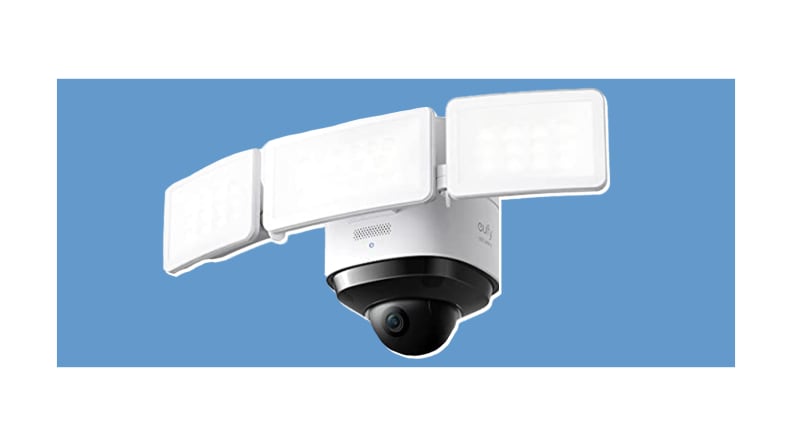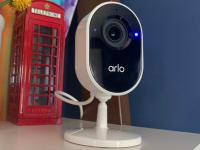 Credit:
Reviewed / Emily Northrop / Arlo
Credit:
Reviewed / Emily Northrop / Arlo
Recommendations are independently chosen by Reviewed's editors. Purchases made through the links below may earn us and our publishing partners a commission.
If you’re venturing into the world of smart security cameras, buckle up. Today’s security space is jam packed with dozens of compelling cameras that meet a vast variety of needs and applications. Ultimately, every camera on the market lands in one of two all-encompassing categories: Wired and wireless.
In a nutshell, the difference between the two is rather self-explanatory. But the existence of a wire, or lack thereof, is really just scratching the surface. Let’s break down each type of security camera and the unique benefits and drawbacks of both styles.
Here’s how to decide between wired vs. wireless security cameras.
What is a wired security camera?

Wired security cameras will constantly have a power source and will provide 24/7 surveillance thanks to that.
In its simplest form, a wired security camera is just that: A security camera that uses some sort of wired connection as a power source. This could be a connection that plugs into a wall outlet, like the Arlo Essential Indoor Camera.
Or, it could be a hardwired connection that intertwines with the existing wiring of your home, like you’ll find in many smart floodlights cameras , like the Eufy Floodlight Cam 2 Pro or smart doorbell cameras, like the Ring Doorbell Wired.
Regardless of which type of wired connection you end up with, the concept is the same. Your camera will have a constant power source to draw from as it works to provide a steady surveillance of your home.
As it turns out, that happens to be the biggest pro of these types of cameras. You won’t have to worry about having to recharge or replace a battery in order to keep these cameras monitoring your space. With some cameras, a hard wired connection allows for 24/7 recording capabilities, like you’ll find with the Nest Doorbell Wired (second-gen).
All you really need is a free outlet or existing wiring to tap into. Your wired security camera will take care of the rest.
Evidently, the cons of wired security cameras are deeply tied to their pros. Something like the Wyze Cam V3 is going to be limited in terms of where it can be placed, simply because it needs to be within a certain proximity of a wall outlet in order to function.
The same applies to hardwired cameras, such as the Google Nest Cam with Floodlight. Unless you want to hire an electrician to migrate wiring to the exact location you want your floodlight to be, you’re going to have to make do with placing your floodlight where your home’s existing wiring lives.
It’s also important to note that wired security cameras only last as long as your power source. That is to say, in the event of a power outage, or even a house guest freeing up some outlet space to charge their phone, your wired camera will be out of commission.
What is a wireless security camera?

Getting these powered and connected via Wi-Fi may be a pain, but you'll be able to place them almost anywhere you want.
If you don’t want to fiddle with cords, then a wire-free security camera setup might be for you. This gives you the freedom to place your camera wherever you want. Battery power is the most popular type of wire-free camera, but outdoor options like the indoor/outdoor Google Nest Cam.
There’s also the Arlo Pro 4 Spotlight Camera, which runs on rechargeable batteries and is designed for outdoor use.
Others, meanwhile, sport the intriguing option of being solar-powered, like the Eufy Solocam S40 and the Ring Stick Up Cam Solar HD security camera.
The best perk of opting for a wire-free security camera is being able to place them wherever you want in your home without having to worry about where to plug in or where to splice into.
Wire-free cameras offer a level of flexibility that wired security cameras simply can’t match. At the same time, wireless security cameras are at the mercy of their battery life. Eventually, you will have to recharge or replace these batteries. When you’ve mounted a wireless floodlight high above your garage, it can be a pain to break out a ladder each time to disconnect, charge, and then reconnect your camera.
One other caveat to consider with wireless security cameras: Wi-Fi. Especially when considering an outdoor installation, you’ll need to make sure your wireless security camera is within range of your Wi-Fi network. Otherwise, you’ll be delegated to spotty connection at best, which can be a significant hindrance to the camera’s ability to provide any real security.
When to use a wired security camera
Wired security cameras are most commonly suited for indoor applications, where you don’t have to worry nearly as much about placement since outlets are likely to be plentiful.
Going the wired route also tends to save you a few bucks over their wireless counterparts, which may come in handy depending on how many cameras you’re hoping to sprinkle throughout your home.
That’s not to say there isn’t a place for wired security cameras outdoors. Hardwired cameras, particularly, can be ideal when it comes to a floodlight or doorbell camera, offering the piece of mind of being constantly connected to power in order to keep an eye on things.
For the most part, though, wired security cameras are often the way to go when looking at indoor security.
When to use a wireless security cameras
Wire-free security cameras thrive in the outdoor space. The no-strings-attached setup makes them remarkably versatile, allowing you to place them in precise locations to be able to monitor specific spaces around your home. As far as your Wi-Fi network reaches, you can mount a wire-free security camera and reap the benefits.
As with the wired cameras before them, wireless security cameras can also be a good option for indoor setups. They just don’t make as much sense inside, mainly because you’ll likely find yourself paying more for a battery-powered camera when you could have opted to plug in and save.
Wired vs. wireless security cameras: Which one should you buy?
At the end of the day, there is virtually no loss in quality between a wired security camera and its wireless counterpart. If they’re in the same tax bracket, they’re likely to offer similar video quality, monitoring features, motion detection and more. In other words, the specs aren’t what set these two types apart.
The choice, then, becomes whether a wired or wireless install is right for the application or space you’re after.
As we’ve noted, indoor setups traditionally call for wired cameras, while outdoor spaces are where wireless cameras can really shine. It’s not always that simple, but it’s a good rule of thumb to abide by when searching for that added layer of security for your home.
The product experts at Reviewed have all your shopping needs covered. Follow Reviewed on Facebook, Twitter, Instagram, TikTok, or Flipboard for the latest deals, product reviews, and more.
Prices were accurate at the time this article was published but may change over time.



